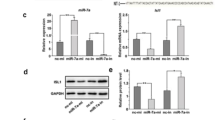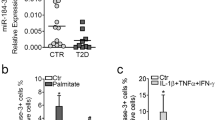Abstract
The main pathogenesis of type 1 diabetes mellitus (T1DM) is autoimmune-mediated apoptosis of pancreatic islet β cells. We sought to characterize the function of microRNA-203a (miR-203a) on pancreatic islet β cell proliferation and apoptosis. In situ hybridization was used to detect the expression of miR-203a in islet β cells in normal and hyperglycaemic non-obese diabetic (NOD) mice. Cell proliferation was measured by cell counting kit eight and cell apoptosis was detected using flow cytometry. Insulin receptor substrate 2 (IRS2/Irs2) was determined to be a direct target of miR-203a by Luciferase reporter assay. We detected the effects of miR-203a overexpression or inhibition on proliferation and apoptosis of IRS2-overexpressing or IRS2-knockdown MIN6 cells respectively, and preliminarily explored the downstream targets of the IRS2 pathway. NOD mice model was used to detect miR-203a inhibitor treatment for diabetes. Our experiment showed miR-203a was upregulated in pancreatic β cells of hyperglycaemic NOD mice. Elevated miR-203a expression inhibited the proliferation and promoted the apoptosis of MIN6 cells. IRS2/Irs2 is a novel target gene directly regulated by miR-203a and miR-203a overexpression downregulated the expression of IRS2. Irs2 silencing reduced cell proliferation and increased apoptosis. Irs2 overexpression could abolish the pro-apoptotic and anti-proliferative effects of miR-203a on MIN6 cells. Hyperglycemia in newly hyperglycemic NOD mice was under control after treatment with miR-203a inhibitor. Our study suggests that miR-203a regulates pancreatic β cell proliferation and apoptosis by targeting IRS2, treatment with miR-203a inhibitors and IRS2 might provide a new therapeutic strategy for T1DM.





Similar content being viewed by others
Abbreviations
- T1DM:
-
Type 1 diabetes mellitus
- miR-203a:
-
MicroRNA-203a
- NOD mice:
-
Non-obese diabetic mice
- IRS2:
-
Insulin receptor substrate 2
- mTOR:
-
Mammalian target of rapamycin
References
Yang W, Lu J, Weng J et al (2010) Prevalence of diabetes among men and women in China. N Engl J Med 362:1090–1101
DiMeglio LA, Evans-Molina C, Oram RA (2018) Type 1 diabetes. Lancet 391:2449–2462
Mathis D, Vence L, Benoist C (2001) beta-Cell death during progression to diabetes. Nature 414:792–798
Zhang R, Hardin H, Huang W, Buehler D (2018) Lloyd RV long non-coding RNA linc-ROR is upregulated in papillary thyroid carcinoma. Endocr Pathol 29:1–8
Ruan W, Xu JM, Li SB et al (2012) Effects of down-regulation of microRNA-23a on TNF-alpha-induced endothelial cell apoptosis through caspase-dependent pathways. Cardiovasc Res 93:623–632
Li H, **e H, Liu W et al (2009) A novel microRNA targeting HDAC5 regulates osteoblast differentiation in mice and contributes to primary osteoporosis in humans. J Clin Invest 119:3666–3677
Zhu Y, Zhang S, Li Z et al (2019) miR-125b-5p and miR-99a-5p downregulate human gammadelta T-cell activation and cytotoxicity. Cell Mol Immunol 16(2):112–125
Serr I, Furst RW, Ott VB et al (2016) miRNA92a targets KLF2 and the phosphatase PTEN signaling to promote human T follicular helper precursors in T1D islet autoimmunity. Proc Natl Acad Sci USA 113:E6659–E6668
Samandari N, Mirza AH, Nielsen LB et al (2017) Circulating microRNA levels predict residual beta cell function and glycaemic control in children with type 1 diabetes mellitus. Diabetologia 60:354–363
Zheng Y, Wang Z, Tu Y et al (2015) miR-101a and miR-30b contribute to inflammatory cytokine-mediated beta-cell dysfunction. Lab Invest 95:1387–1397
Zhao L, Yu H, Yi S et al (2016) The tumor suppressor miR-138-5p targets PD-L1 in colorectal cancer. Oncotarget 7:45370–45384
Shirakawa J, Terauchi Y (2017) Glucose- or insulin resistance-mediated beta-cell replication: PKCzeta integrates the proliferative signaling. J Diabetes Investig 8:149–151
White MF (2003) Insulin signaling in health and disease. Science 302:1710–1711
Stamateris RE, Sharma RB, Kong Y et al (2016) Glucose induces mouse beta-cell proliferation via IRS2, MTOR, and cyclin D2 but not the insulin receptor. Diabetes 65:981–995
Covach A, Patel S, Hardin H (2017) Lloyd RV phosphorylated mechanistic target of rapamycin (p-mTOR) and noncoding RNA expression in follicular and hurthle cell thyroid neoplasm. Endocr Pathol 28:207–212
Cosimo E, Tarafdar A, Moles MW et al (2019) AKT/mTORC2 inhibition activates FOXO1 function in CLL cells reducing B cell receptor-mediated survival. Clin Cancer Res 25(5):1574–1587
Yoon MS (2017) The role of mammalian target of rapamycin (mTOR) in insulin signaling. Nutrients 9(11):1176
Bluestone JA, Herold K, Eisenbarth G (2010) Genetics, pathogenesis and clinical interventions in type 1 diabetes. Nature 464:1293–1300
Lin Y, Sun Z (2015) Antiaging gene klotho attenuates pancreatic beta-cell apoptosis in type 1 diabetes. Diabetes 64:4298–4311
Zhang J, Zhang N, Liu M et al (2012) Disruption of growth factor receptor-binding protein 10 in the pancreas enhances beta-cell proliferation and protects mice from streptozotocin-induced beta-cell apoptosis. Diabetes 61:3189–3198
Filipowicz W, Bhattacharyya SN, Sonenberg N (2008) Mechanisms of post-transcriptional regulation by microRNAs: are the answers in sight? Nat Rev Genet 9:102–114
Nesca V, Guay C, Jacovetti C et al (2013) Identification of particular groups of microRNAs that positively or negatively impact on beta cell function in obese models of type 2 diabetes. Diabetologia 56:2203–2212
Sand M, Gambichler T, Sand D et al (2009) MicroRNAs and the skin: tiny players in the body's largest organ. J Dermatol Sci 53:169–175
Sonkoly E, Stahle M, Pivarcsi A (2008) MicroRNAs and immunity: novel players in the regulation of normal immune function and inflammation. Semin Cancer Biol 18:131–140
Demozay D, Tsunekawa S, Briaud I et al (2011) Specific glucose-induced control of insulin receptor substrate-2 expression is mediated via Ca2+-dependent calcineurin/NFAT signaling in primary pancreatic islet beta-cells. Diabetes 60:2892–2902
Jain S, Ruiz de Azua I, Lu H et al (2013) Chronic activation of a designer G(q)-coupled receptor improves beta cell function. J Clin Invest 123(4):1750–1762
Nakamura A, Terauchi Y (2015) Present status of clinical deployment of glucokinase activators. J Diabetes Investig 6:124–132
Norquay LD, D'Aquino KE, Opare-Addo LM et al (2009) Insulin receptor substrate-2 in beta-cells decreases diabetes in nonobese diabetic mice. Endocrinology 150:4531–4540
Yang F, Takagaki Y, Yoshitomi Y et al (2019) Inhibition of dipeptidyl peptidase-4 accelerates epithelial-mesenchymal transition and breast cancer metastasis via the CXCL12/CXCR4/mTOR axis. Cancer Res 79(4):735–746
D'Agati VD, Chagnac A, de Vries AP et al (2016) Obesity-related glomerulopathy: clinical and pathologic characteristics and pathogenesis. Nat Rev Nephrol 12:453–471
Laplante M, Sabatini DM (2012) mTOR signaling in growth control and disease. Cell 149:274–293
Dong G, Liu Y, Zhang L et al (2015) mTOR contributes to ER stress and associated apoptosis in renal tubular cells. Am J Physiol Renal Physiol 308:F267–F274
McIntosh CH, Widenmaier S, Kim SJ (2012) Glucose-dependent insulinotropic polypeptide signaling in pancreatic beta-cells and adipocytes. J Diabetes Investig 3:96–106
Ardestani A, Lupse B, Kido Y et al (2018) mTORC1 signaling: a double-edged sword in diabetic beta cells. Cell Metab 27:314–331
Funding
This study was funded by the National Natural Science Youth Foundation of China (81402272, 81702797), the Hunan Provincial Natural Science Foundation of China (2018JJ3745,2018JJ2213) and the New **angya Talent Project Funding of the Third **angya Hospital of Central South University (JY201627).
Author information
Authors and Affiliations
Corresponding author
Ethics declarations
Conflict of interest
The authors declare no conflict of interest.
Ethical approval
This article does not contain any studies with human participants or animals performed by any of the authors. All applicable international, national, and/or institutional guidelines for the care and use of animals were followed.
Additional information
Publisher's Note
Springer Nature remains neutral with regard to jurisdictional claims in published maps and institutional affiliations.
Electronic supplementary material
Below is the link to the electronic supplementary material.
Rights and permissions
About this article
Cite this article
Duan, X., Zhao, L., **, W. et al. MicroRNA-203a regulates pancreatic β cell proliferation and apoptosis by targeting IRS2. Mol Biol Rep 47, 7557–7566 (2020). https://doi.org/10.1007/s11033-020-05818-4
Received:
Accepted:
Published:
Issue Date:
DOI: https://doi.org/10.1007/s11033-020-05818-4




